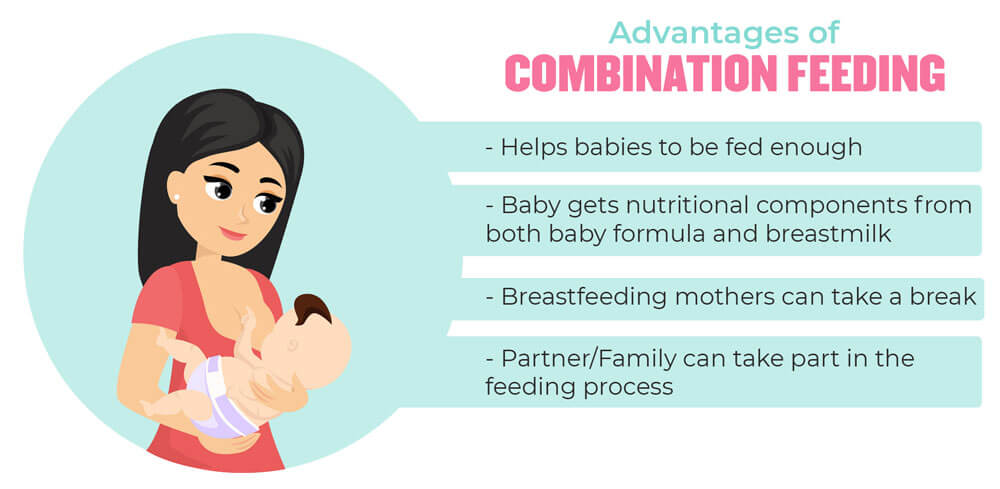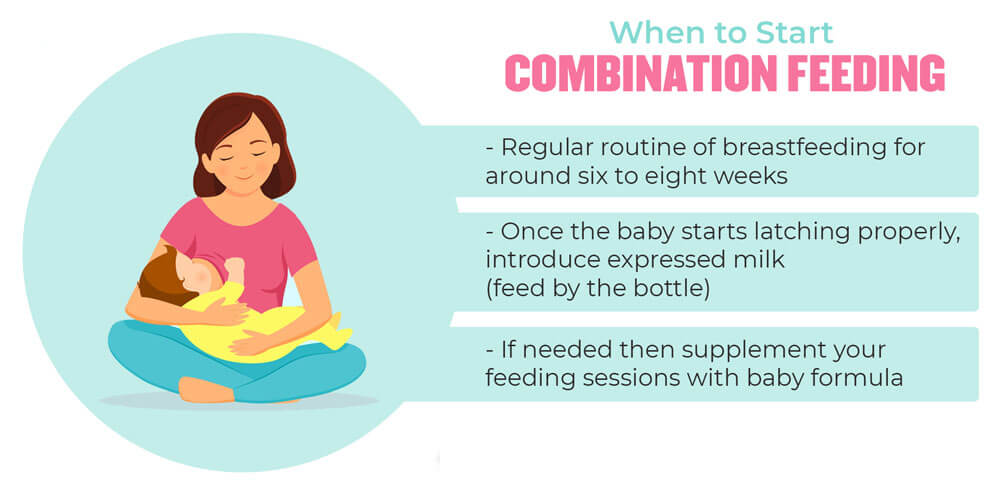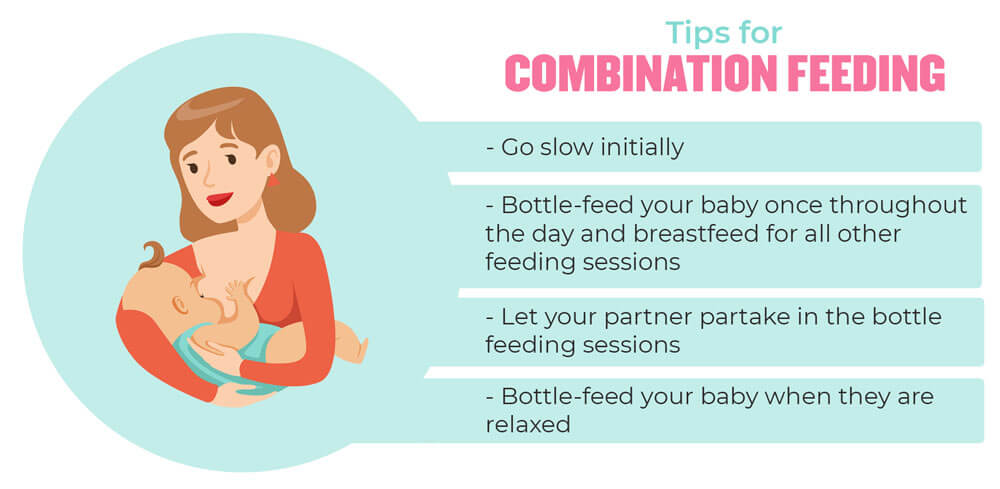Combination Feeding | How to Combine Breast & Bottle Feeding

As a new parent, you may be getting all sorts of advice from all sorts of people – even from people you don’t know. One of the most common advice that people give new parents is about feeding – and in particular, breastfeeding. There is a ton of stigma surrounding any other form of feeding and this can be quite daunting for new parents who still do not know whether they want to breastfeed their baby or try an alternative.
Yes, breastfeeding is not the only way that you can be feeding your baby – you can attempt combination feeding or mixed feeding as well, which has a myriad of advantages that we’ll get into later in this article.
There are a variety of reasons why a new parent may start combination feeding – and in many cases, it might actually be the more convenient option as opposed to breastfeeding. Let’s see what combination feeding is and why it is an excellent alternative to exclusive breastfeeding – and of course, what is the proper method of combination feeding your little one.
What is Combination Feeding/Mixed Feeding?
The first question that you probably have is what is combination feeding, combi feeding, or mixed feeding? You do not have to feed your baby in one particular way. Combination feeding refers to the phenomenon in which you feed your baby both through breastfeeding and bottle feeding.
The contents of your bottle could be either breast milk or baby formula – it’s totally up to your discretion. While there are a lot of stigmas attached to exclusively breastfeeding your baby as being the only way to go, it is definitely not so – you could try combination feeding to see some surprisingly positive results in your baby’s feeding experience.
Advantages of Combination Feeding

There are multiple advantages to combination feeding baby. If you’re still not convinced about the case of introducing combination feeding from birth, then you might want to look over these advantages to keep your options open in terms of feeding your baby.
Exclusively breastfeeding your baby may mean that your baby would need to rely only on you for their feeding sessions. This excludes your partner and the rest of your family, who may want to partake in the feeding process in order to bond with the baby as well. While combination feeding, you can either choose to express your own breast milk or use baby formula in order to make your partner and/or family part of the feeding process as well.
Not only does your baby start to feel safe and attached to them after a few feeding sessions, but it also enables you to get in some much-needed rest or time for yourself. Since babies find it exceptionally easy to fall asleep right after they have been breastfed, you can stimulate the same when you’re bottle-feeding your baby as well – hence, just before they’re going to sleep, attempt to bottle-feed them so they sleep longer and better.
Both baby formula and breastmilk contain nutrients that are crucial to the baby’s development – so they can get the best out of both nutritional components just as easily by alternating between both of them.
And lastly, of course, it is an easier process to begin weaning for you and your baby once they have already got accustomed to bottle-feeding, as compared to babies who have been solely breastfed.
Why Combine Breast and Bottle?
There are a variety of reasons why you would decide to start mixed feeding or combination feeding. If your baby is facing difficulty in adjusting to breastfeeding, then you would want to introduce some intermittent bottle feeding in order to make the feeding process easier for your baby – whether it be breast milk or baby formula.
Additionally, if you’re planning to leave your baby for extended periods of time for any purpose, then you’d be unable to feed your baby on time. Getting them used to bottle-feeding along with breastfeeding would mean that they wouldn’t fuss once they need to be fed by the bottle. You might also want to restart breastfeeding after having bottle-fed your baby for a while, so combination feeding is a great way to enforce this.
Whatever your reasons might be – even if you simply want to replace a couple of your breastfeeding sessions with bottle-feeding instead, then you can do so by following some very simple steps.
It is important to keep in mind, however, that baby formula can often have an impact on the production of breastmilk. If you don’t get your baby used to combination feeding, then they may find it difficult to breastfeed after having been bottle-fed for a while since the sucking motion differs for both of them.
When to Start Combination Feeding

Now that you know the basics of what combined feeding is and why it is employed by new parents, you might want to know when the optimum time to begin breastfeeding is. The first thing you’ll need to know is that you have to establish a pretty regular routine of breastfeeding for a while before you can introduce combination feeding in any way.
Only after you have established a constant breastfeeding routine for around six to eight weeks and made sure that your baby is latching properly on should you bring in expressed milk to be fed by the bottle to your baby.
As mentioned before, your supply of breast milk can be largely affected by whether you’re using baby formula to feed your baby or not. If you’re using baby formula regularly for your little one’s feedings, then your breast milk supply can go down.
If breastfeeding is difficult to incorporate as a routine for you and your baby, you would need to supplement your feeding sessions with baby formula. To increase your supply of breast milk, you can attempt to express your breast milk regularly.
How to Combination Feed

If you’re wondering how to combination feed your baby, there are many ways in which you can slowly and gradually introduce breast and bottle feeding to your baby in order for them to become quickly familiar with it. Something that is crucial especially if you’re going to be returning to work soon or going away for a period of time due to some reason.
It is best to begin combination feeding by introducing bottle-feeding to your baby once throughout the day and then breastfeeding for all other feeding sessions. You can do this even while they’re breastfeeding, or before or after – try all of these options to figure out which one suits you the most. And since babies are quite fond of routine and feel comfortable with it, it’s best to initially introduce bottle-feeding at the same time of the day every day.
It is best if you let your partner or another trusted person partake in the bottle-feeding sessions for a variety of reasons. If your baby smells you, they’re more likely to refuse to be bottle-fed because they’ll think they’re going to be breastfed.
You can take this time of the day to rest – it is also great if you decide to introduce your baby to bottle-feeding when they’re feeling relaxed, as opposed to when they’re hungry. You can also try asking the person bottle-feeding your child to hold them differently than when they’re breastfed.
Bottle-feeding with baby formula can be tricky, but it is best to go slow initially – since this would give time for your lactation cycle to adjust to the milk reduction and avoid a host of other problems such as mastitis or swollen breasts. You can also opt to express your breastmilk and store it away in the freezer – keep in mind that your breastmilk supply is usually plenty in the morning, so you can take advantage of this.
How to Introduce a Bottle to a Breastfed Baby
As mentioned before, it is best to hold your baby differently than how the position in which they’re breastfed. When you’re initially introducing a bottle to your baby who is usually breastfed, try to keep them almost upright and close to you or someone else as they’re being fed.
You can also offer the teat of the bottle to them gradually so that they accept it into their mouth and make sure they’re latching on to it in the proper manner, i.e., there’s no room for them to suck in an excessive amount of air.
Additionally, if they’re not taking to the teat of the bottle then you might want to try different bottles in order to select one which suits them – you could also try softening this teat with the help of warm water. If you want to know more about introducing your usually breastfed baby to a bottle, then you could refer to this guide.
How to Reduce Bottlefeeding and Restart Breastfeeding
If you’ve been combination feeding or mixed feeding your baby for a while but want to switch back to exclusively breastfeeding, it will take some patience. As you may have learned by now, the more you pump your breastmilk or breastfeed your baby, the more regular your lactation cycle is and the more milk your breasts can produce.
So to increase your breastmilk supply, you’ll have to start expressing your breastmilk whenever possible – as many as eight times during the day – and once you feel like you can, then you should start breastfeeding your baby as regularly as you can since this will increase your breastmilk supply as well.
To get your supply of breastmilk up, you should also attempt to cuddle your baby as much as possible and try to feed them when both you and the baby are relaxed – this produces oxytocin in your body, which then increases your breastmilk supply. Try to feed your baby as often as possible, especially if it feels like they’re not feeding an adequate amount at once.
Also read: What is Dream Feeding and How to Dream Feed?
Our Advice
Combination feeding can be a great alternative to solely breastfeeding your baby – and while you may initially be discouraged by naysayers, it’s perfectly alright and normal to attempt to combination feed your baby for a while or even switch back to breastfeeding whenever you feel like you can.
No matter what your reasons might be, it is important to keep both your comfort and your little one’s comfort in mind, especially during feeding. With the many advantages to combination feeding, you can try all the aforementioned ways in order to get your baby used to combination feeding as quickly as possible – allowing for a happy and sated baby!

Laura is a trained primary teacher who takes a profound liking in interacting with and bringing out the best in children. She is also an ISSA certified pediatrician with an extensive practice of over 12 years. Laura comprehends the needs of infants and now compresses her expertise into writing thorough parenting guides to aid new parents.






